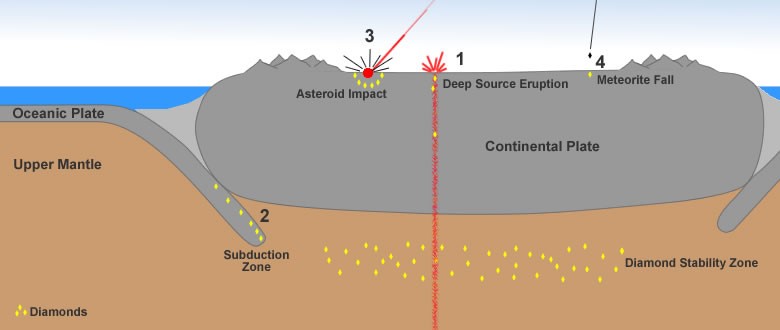Making of a Diamond |Schwanke-Kasten Jewelers

With the DIAMOND being April’s birthstone and used is almost every engagement ring mounting, we thought it would be only fitting to share with you, “The Making of a Diamond”.
In fact, this past month, we witnessed the largest internally flawless diamond the GIA has ever graded sold for $71.2 Million (USD)! The Pink Star was cut from a 132.50 carat rough diamond back in 1999 and then polished by master diamond cutters for over two years. The end product produced a 59.60 carat diamond that was fancy vivid pink color.
The Making of a Diamond
Despite popular opinion, most natural diamonds are, in fact, not made of compressed coal. We will call that the Superman Theory.
In fact, “Almost every diamond that has been dated was formed during the Precambrian Eon – the span of time between Earth’s formation (about 4,600 million years ago) and the start of the Cambrian Period (about 542 million years ago). In contrast, the earliest land plants did not appear on Earth until about 450 million years ago. Moreover, this is nearly 100 million years after the formation of virtually all of Earth’s natural diamonds.” – Geology.com
How do diamonds form?
In fact, the formation of natural diamond requires very specific conditions. According to Live Science, nature’s recipe for diamonds is the following:
- Bury carbon dioxide 100 miles into the Earth
- Heat to about 2,200 degrees Fahrenheit
- Apply pressure of 725,000 pounds per square inch (hence Superman)
- Quickly rush towards Earth’s surface to cool.
There are two places on earth that meet those conditions; in the lithospheric mantle (right below the continental plates) and at the site of a meteorite strike.
Deep Source Eruptions
The most common way diamonds are formed are from “Deep Source Eruptions” – a process that can take upwards to 1 billion years!
- The mantle produces immense pressure and heat to form diamonds. After forming, deep volcanic-like eruptions violently thrust the diamonds towards the crust. These produce kimberlite and lamproite pipes.
- Kimberlite pipes (named after the city where the Star of South Africa was discovered) are the most important carrier of diamonds and garnets, forming in a carrot shape between 93 and 280 miles beneath the surface. These pipes allow exotic minerals from the mantle to surface (Science Daily).
- Lamproite pipes are a far more common occurrence yet rarely prove to be a reliable source for diamonds. Scientists say the difference between Lamproite pipes and Kimberlite pipes are that Lamproite are shaped like champagne flutes and shallower than Kimberlite pipes.
- There are three other ways that scientists have discovered diamond creations but are far rarer than Deep Source Eruptions.
- Subduction Zones:
- Scientists believe that minerals, previously subducted by an oceanic plate going under a continental plate due to plate tectonics are another form that may actually involve coal as a source of carbon! However, this is also incredibly rare.
- The other two deal with extraterrestrial objects entering the Earth’s atmosphere and the rarest!
- Asteroid Impacts
- Meteorite Fall
- Subduction Zones:
Next time you are looking at diamonds remember the amount of time and extraordinary circumstances needed to create them. Explore some of our extraordinary diamond jewelry, and stay tuned as we look into the history of diamonds in the modern world!

